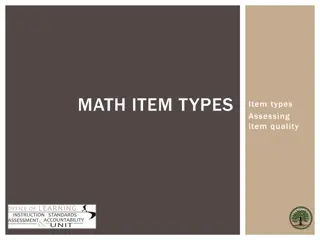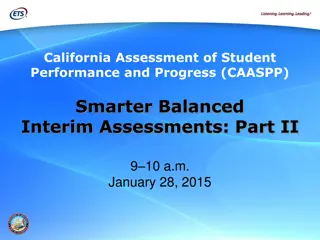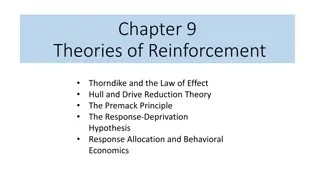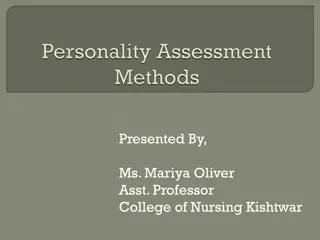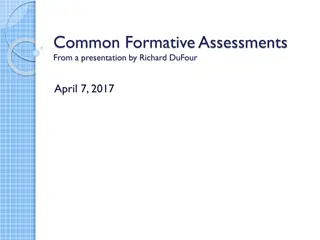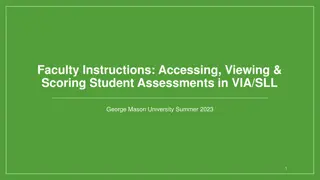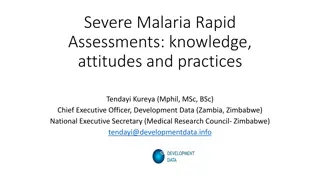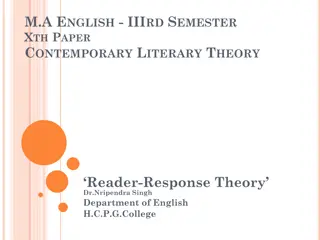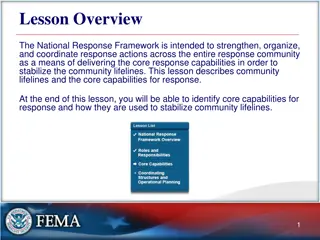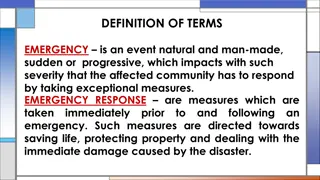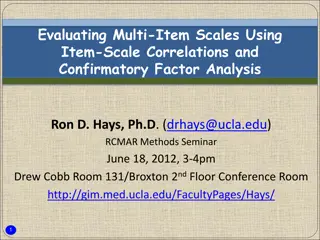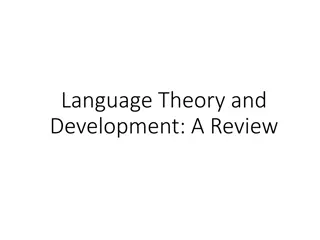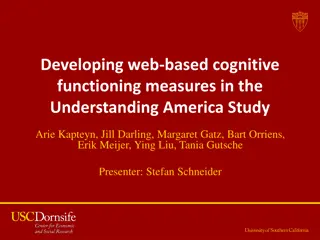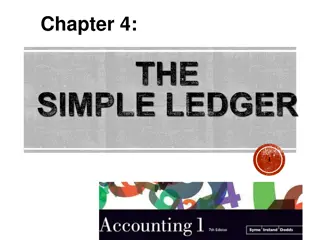Understanding Item-Response Theory (IRT) in Educational Assessments
This lecture covers the design and use of test scores, focusing on the principles of Item-Response Theory (IRT) in large-scale international assessments. IRT aims to measure latent traits reliably by analyzing individual question responses rather than just total scores. The advantages of IRT over Classical Test Theory (CTT) are highlighted, emphasizing independence of scores, flexibility in question sampling, and the ability to separate examinee and test characteristics. Key concepts such as Item Characteristic Curves (ICC) are explained to illustrate how IRT models the probability of correct responses based on item difficulty, discrimination, and guessing.
Download Presentation

Please find below an Image/Link to download the presentation.
The content on the website is provided AS IS for your information and personal use only. It may not be sold, licensed, or shared on other websites without obtaining consent from the author. Download presentation by click this link. If you encounter any issues during the download, it is possible that the publisher has removed the file from their server.
E N D
Presentation Transcript
The design and use of test scores Lecture 4 1
Aims of the lecture 1. To understand how the large scale international assessment tests are designed 2. To understand what plausible values are, why they are used and how they should be analysed. 3. Provide a basic understanding of Item-Response Theory (IRT), including how their use differs across the large scale international assessments 4. Gain experience of analysing plausible values using the PISA dataset. 2
NOTE This is not a course about IRT! I am going to give you a quick crash course in it . Why? Because the international assessments use it . So you will need to know about it (even at a superficial level) Will also feed into what I say later in the lecture . 4
What is item response theory (IRT)? Idea Ability in any given area is an unobserved latent trait Want to be able to measure this trait on a reliable scale. To measure this latent trait, we give children a test with a number of questions . - Each question marked as 0 for incorrect and 1 for correct. Classical test theory (CTT) We simply add up the number of correct responses and give children a total score Item-response theory (IRT) Interest is whether child got each question right or not .. .one models the probability of a correct response 5
Why use IRT over CTT? IRT Scores test independent . .scores do not depend upon the particular questions you ask in the test Scores sample independent . .scores do not depend upon the particular sample you give the test Examinee and test characteristics can be separated from one another .. Standard error of measurement differs across ability of the examinees .. .i.e. there is no single reliability
Why use IRT over CTT? http://ncme.org/linkservid/66968080-1320-5CAE-6E4E546A2E4FA9E1/showMeta/0/
IRT: Item characteristic curves (ICC) There is some underlying latent trait we are interested in (?) At each level of this latent trait, there is a certain probability of getting the question correct .. This can be represented by item characteristic curves (ICC) Shape of ICC determined by three factors .. Item difficulty (b) Item discrimination (a) Guessing (c) 8
ICC The difficulty parameter (b) Item difficulty influences the horizontal location of the ICC .. Questions furthest to the right are harder .. lower probability of correct response at any given value of underlying latent trait Note: ICC s can t cross if only b changes .. 9
The discrimination parameter (a) Item discrimination influences the slope of the ICC .. Some questions that high ability children find (comparatively) hard (relative to other questions) . low ability children find (comparatively) easy ICC s can cross when discrimination changes .. 10
The guessing parameter (c) Asymptote not at 0 .. There is some non-zero probability that even a child with very low ability gets the test question correct E.g. Children can guess the correct answer .. 11
Three different types of IRT model 1PL (Rasch) model a = 1 and c =0 All items discriminate equally .. No guessing .. Probability of correct response only depends upon two factors: - Test taker s ability (?) - Difficulty of item (b) 2PL model c =0 Discrimination differs across items. No guessing .. 3PL model a, b and c all estimated Questions differ in discrimination . Guessing can influence probability of correct response . Questions of varying difficulty .. 12
Using IRT to produce test scores Step 1: Choose which IRT model you are going to fit Step 2: Use data to estimate the item-parameters (a, b and c) .. Step 3: Use maximum likelihood (an iterative procedure) and pupils responses to each test question (and possibly other information) to estimate their ability on latent trait (?) .. . {steps 2 and 3 above essentially fitting a conditional logit random effects model, with test questions nested within individuals) Step 4: As pupils ability is only estimated, one can also calculate a standard error for their ability (under the assumption they could take multiple different versions of the same test). 13
Assumptions of IRT modelling. All test questions tap a single latent trait - There is a single latent ability .. - .there are a well defined set of test questions that all measure this latent trait That there is no differential item functioning (DIF) - DIF = Different groups with same value of latent trait (?) have different probabilities of giving correct response to a test question . - E.g. Conditional upon latent maths skills (?) children in country A are more likely to answer a certain maths question correctly than children in country B . Local independence of items . - Conditional upon ?, the probability of getting question A correct is not associated with the probability of getting question B correct. 14
Does which IRT model you use make a difference? Inequality (P95 P5) Median Source: Brown et al (2007). International surveys of educational achievement: How robust are the findings? 15
Why is all this important? The large scale international assessments all use some form of IRT to scale children s responses into overall test scores PISA = 1PL (Rasch) model {Though soon moving towards a 2PL model as of 2015} PIAAC = 2PL model TIMSS = 3PL model PIRLS = 3PL model IRT is central to how PISA scores are created . 16
How are the large scale international assessments designed 17
The test design an outline Studies like PISA try to cover a lot of ground. Tests children in three domains (reading, maths and science) .these domains are themselves made up of sub-domains. E.g. PISA maths made up of the following sub-domains: - Change and relationships - Quantity - Shape and space - Uncertainty and data A lot of ground to cover! And PISA is only a 2 hour exam .. Therefore not all children can take all questions (or even cover all areas) Hence the international assessments use multiple-matrix sampling (MMS) 18
What is MMS? In a nutshell Not every child takes every test question from each of the three domains . .therefore, each child takes a random sample from the population of questions Therefore, each child is measured using a sample of test items. Advantages Allows for broad content coverage (in reasonable time) across the pool of test takers . So PISA 2012 provides estimate for reading, science, maths and 4 maths content sub-scales Disadvantages Large amount of measurement error at the pupil level .. Not suitable for pupil level reporting (can t feed back results to schools / pupils) 19
How is MMS implemented in PISA? PISA 2009 - 131 reading items ( major domain ) - 34 maths items ( minor domain ) - 53 science items ( minor domain ) These test items were divided into 13 clusters - 7 science clusters - 3 reading clusters - 3 maths clusters Each cluster includes 30 minutes of test material These clusters were then separated into 20 separate test booklets - Each booklet contains 4 of the 13 clusters . 20
How is MMS implemented in PISA? Booklet Clusters 1 M1 R1 R3 M3 2 R1 S1 R4 R7 3 S1 R3 M2 S3 4 R3 R4 S2 R2 5 R4 M2 R5 M1 6 R5 R6 R7 R3 7 R6 M3 S3 R4 8 R2 M1 S1 R6 9 M2 S2 R6 R1 10 S2 R5 M3 S1 11 M3 R7 R2 M2 12 R7 S3 M1 S2 13 S3 R2 R1 R5 14 M1 R1 R3 M3 15 R1 S1 R4 R7 16 S1 R3 M2 S3 17 R3 R4 S2 R2 18 R4 M2 R5 M1 19 R5 R6 R7 R3 20 R6 M3 S3 R4 Random allocation Each child in PISA is randomly allocated one of these 20 booklets . Notice Not all booklets cover each domain E.g. Booklet 2 No maths questions! But.... In the PISA file test scores will appear for every child in each domain E.g. Maths test scores will be included for all children (even those who took test booklet 2) 21
Implications As different children take different versions of the test ..PISA / TIMSS etc not suitable for individual reporting Raw scores and percentage correct not comparable across students .. as children have completed different booklets But, it is argued, can provide robust estimates of performance at the group (e.g. country) and sub-group (e.g. gender) level The large scale international assessments do this by using latent regression item response theory Based upon Mislevy (1984, 1985) and development work by the Educational Testing Service. Overview provided in the slides that follow .. Latent regression = Random effect conditional logit model .. 22
Latent regressions and the imputation of plausible values . 23
Starting point.. Argument Latent trait (?) is missingfor all respondents .. I.e. We can never observe children s skill in maths . can only observe manifestations of this skill (e.g. answers to test questions) Implication In large scale educational survey assessments, 100% of the student proficiency data is imputed (von Davier 2013:184) PISA / TIMSS / PIAAC test scores (?) are essentially multiple imputations of children s ability . 24
How does MMS test design feed into this?? Recall from IRT IRT models are essentially random effect conditional logit models . .where responses to test questions are nested within individuals .. MMS Each pupil will be missing some test question responses by design .but, as booklets (and hence test questions) randomly assigned, .it is reasonable to assume that these data at Missing Completely At Random (MCAR) The missing item data is ignorable Unbiased estimates obtainable from sub-sample of responses . . But by using imputation we boost efficiency 25
How are the multiple imputations produced? Step 1: Item calibration - Fit an IRT model to children s responses to the test questions . - Gets estimated item parameters ( b ) - E.g. b = Item difficulty under Rasch model . Step 2: PCA performed on the background variables - All large scale international surveys contain background variables (z) - E.g. Gender, SES, immigrant status etc - Perform a PCA on all these variables .. - retain as many components as needed to explain 90% of the variance 26
How are the multiple imputations produced? Step 3: Latent regression model fitted - AKA: a random effects logit model where . - Probability of correct response to a question depends upon . - Question difficulty (calculated in the item calibration stage) . - Background variables (z) . - Latent trait (?) Purpose = Produce parameter estimates ( ) for impact of background variables (z) and residual variance covariance matrix ( ) Step 4: Generate plausible values - Using estimates of b, , and from steps 2 and 3 . - .obtain the plausible values (PV s) PV s = Multiple imputations based upon latent regression model estimated in step 3 27
Result This is a clearly a complex procedure .. .and one that is not replicable by the vast majority of people .(including PhD s in statistics who know quite a lot about PISA!) Focus on the implications The result is that the large scale international assessments includes several test scores (plausible values) for each student in each cognitive domain .. These are five different estimates of children s ability (?) in that area . Intuition Reflect uncertainty in our knowledge of children s true skill Has a bearing on how we should analyse the data .. 28
How plausible values look in PISA. Notice A lot of variability in these PV at the individuallevel difference of 150 points (approx. 3 years of schooling) ID PV1MATH PV2MATH PV3MATH PV4MATH PV5MATH 1 281 298 164 280 319 2 245 280 244 175 216 Too much uncertainty in individual pupil results to report them back 3 486 449 457 423 427 4 356 284 323 286 237 Key point This uncertainty is greatly reduced when looking at group (or sub-group) level .. 5 381 342 439 368 307 29
Intuition. Differences between the PV s can be thought of as differences due to (random) measurement error (ME) .. This measurement error is due to a lack of precision in the test . ..I.e. Test reliability less than 1.0 (not test is perfect!) ..If it were, all PVs equal the same value Think about a simple OLS regression, where dependent variable (A) suffers random ME: A = ? + ?.? + ? Well know that parameter estimates unbiased .but standard errors will be inflated relative to if A were measured perfectly PV s take into account extra uncertainty in estimates due to measurement error! 31
In a nutshell. Plausible values created using multiple imputation methodology . Therefore, the appropriate use of PV s essentially follows Rubin s Rules and the MI literature . Estimate statistic of interest using each PV s separately .. Then combine these estimates using what is essentially the same formula as for combing MI estimates for missing data These estimates will reflect the uncertainty due to the measurement error in the test score data 32
Standard error now has two components. Standard error = Sampling variance + Measurement error variance 33
Illustrate through following example Want to estimate the following OLS model across countries: ? = ? + ?.??? + ? Where: A = Academic ability in mathematics (as measure by e.g. PISA) SES = A continuous measure of socio-economic status And: ? = The estimated association between SES and achievement Following steps needed to obtain correct point estimates and standard errors for ? 34
Step 1: Calculating the point estimate and sampling variance for PV1 Point estimate simply ? when using PV1 as the dependent variable. I.e. ??1= ? + ?1 .??? + ? (1) Sampling variance a little more tricky .remember the replicate weights [Lecture 2!] Need to re-estimate equation 1 Rtimes (once using each replicate weight) . .and then combine using the relevant formula. E.g. For PISA (80 BRR weights with Fay adjustment): ? 2 1 ? ?? (where k =0.5 and R = Replicate R) ?(1 ?)2 1 ?????= Just as we did previously in the TALIS workshop 35
Step 2: Repeat step 1 for each PV.. Repeat the analysis for each of the PV s in the dataset .. If you have 5 PV s (as in PISA) you will now have: Five point estimates of SES gradient = [?1 Five estimates of sampling variance= [?1 ] , ?2 , ?2 ;?3 ;?3 ; ?4 ; ?4 ; ?5 ; ?5 ] Note Computer intensive! Assuming 5 PV s and 80 replicate weights .. .will have estimates 405 regression models to get to this point Quick enough for simple models (e.g. OLS) .Can take a long time for complex models (e.g. quantile regeressions) 36
Step 3: Obtain pooled estimate of ? and sampling variance Simply take the mean of the estimates calculated in step 2. ? =[?1 + ?2 +?4 5 +?5 ] +?3 Final point estimate of SES gradient in the country ? =[?1 + ?2 +?4 5 +?5 ] +?3 Final estimate of the sampling variation . 37
Step 4: Calculate the measurement error (imputation) variance ?? (??? ? )2 ?? 1 ??=1 ???= Calculate the difference between 1 (estimate using PV1) and * (pooled estimate). Then square it . Repeat for PV2, PV3, PV4 and PV5 (assuming that there are five PV s) Add these values together. Divided this value by the number of PV 1 ( i.e. divide by 4, if there are five PV s) Gives you uncertainty due to measurement error . (This is the whole point of having five PV s) 38
Step 5: Combine the sampling variance and measurement error variance Sampling variance and measurement error variance are combined using the following formula .. 1 2 2 2 ?????? = ????? + 1 + .??? ?? NOTE: Similarities between this and the standard formula for error estimation within multiple imputation literature . Impact of measurement error component bounded between: Lower bound = 1.5* ??? Upper bound = ??? 2when only two PV s are used .. 2when PV s are used This when large number of PV s (imputations) used . .can simply add sampling variance to error variance 39
Step 6: Calculate the standard error. 2 Standard error of = ?????? Simply the square root of the total error .. Can now use this to calculate confidence intervals and perform hypothesis tests as usual 40
Numerical example Estimate of mean PISA score for Germany in 2003 41
Steps 1 and 2: Calculate point estimate and sampling variance for each replicate 5 different point estimates 80 replicate estimates using each PV 5 sampling variance estimates 42
Step 3: Obtain pooled point estimate and sampling variation This is the final estimate of the mean score for Germany .. .everything else is about the standard error Estimate of the sampling variance .. does not include the ME variance 43
Step 4: Calculate the measurement error (imputation) variance Final estimate of mean for Germany Number of PV 1 = 4 44
Step 5: Combine the sampling variance and measurement error variance Sampling variance and measurement error variance are combined using the following formula .. 1 2 2 2 ?????? = ????? + 1 + .??? ?? Step 6: Calculate standard error 45
Note: Tiny role ME actually plays here.. Standard error excluding ME component = 3.3136 Standard error including ME component = 3.3166 Including the ME component has increased the SE by less than 0.1%....... My experience = Including ME component makes very little substantive difference to PISA results . . To the point I believe it is largely ignorable! Note Doing your analysis using just one plausible value will actually give you: - Unbiased point estimate of statistic of interest - Unbiased estimate of sampling variance What you miss out on is the imputation variance - But probably bigger fish to fry!? - Isn t life too short anyway!? 46
PV as independent variables Thus far, have implicitly assumed that PISA scores are the outcome of interest .but we may want to use PV s as a covariate in our study Official line on how your analysis should proceed There is a lot less discussion about this issue! Implicitly assumed that same logic / methodology to be used I.E. Estimate model several times using one PV each time and then average the results But I am not sure this logic holds 48
Problem with PV as independent variable.... As noted previously, recognised that the PV s contain (random) measurement error . When PV s are the dependent/outcome variable, this will only impact upon standard error / efficiency of estimation .. . Hence why ME only contributions to standard error But same logic does not hold true with classic measurement error in covariate .. Leads to downward bias in point estimate (attenuation bias) .. . Will also lead to bias point estimates for all other variables included in the model Not clear if / how PV s can be used to overcome this problem 49
Example: SES and university expectations in Australia Want to examine relationship between SES and expectations of going to university .. .both before and after controlling for differences in reading ability Two approaches Option A: Estimate model 5 times, once use each PV, and average coefficient estimates. Option B: Included all five PV in a single model. Logic - Bollinger and Minier (2012). Best way to control for unobserved latent factor is to include all available proxies . Prediction SES parameter estimate under option A will be higher than under option B Why? Option A will only partially control for confounding effect of reading ability (because of ME) Option B will more fully control (better account of ME) 50



